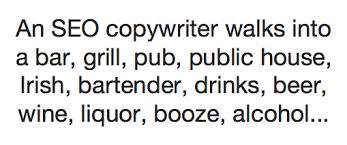If there’s one thing constant about SEO, it’s the fact that the game is constantly changing. The minute you finish an article about Google algorithm changes, three more about recent trends pop up.
It can be intimidating to keep up.
However, there’s one major thing that changed in SEO writing recently. Remember this?

It’s finally gone! Keyword stuffing is thankfully a thing of the past! We can now write naturally. Nay, we have to write naturally if we want any hope to rank soon.
At Idunn, the digital marketing agency I run, a big part of our work is writing SEO content for our clients and for ourselves. 99% of our clients come because they love what we write. It’s been six years since I launched Idunn and I invested ~$500 in ads. Everything else happened organically.
These are the rules we always abide by when writing SEO content for ourselves or for our clients:
1. Always Start with Your Buyer Persona
Before you dig into keyword research and even before you think about your topic, take a moment to consider whom you are writing for.
Joe Pulizzi said it best:
“If your content marketing is for everybody, it’s for nobody.”
Don’t fall into the oldest marketing trap and believe that the wider the net you cast, the more fish you will catch. Things don’t work this way in marketing anymore.
Why do you need a buyer persona to write great SEO content, you ask?
After all, the piece can rank even if the ideal client doesn’t like it, right?
Well, not really.
Bounce rate is one of the ranking factors. If a user bounces back to the search results page after spending just a few seconds on your landing page or blog post, it’s a signal for Google that your content is not good enough. And it will be demoted.
More importantly, you shouldn’t be writing SEO content just to get traffic. Traffic is a vanity metric. Your SEO efforts should support your business goals.
In other words: your SEO content should sell or help collect leads. That doesn’t happen if it’s not written with the buyer persona in mind.
Better yet, creating a buyer persona will also help you zero in on the keywords to use, the ideal tone of voice and where to promote your content.
You can get started on creating your buyer persona with this HubSpot free tool.
2. Get Specific with Your Topics
(You’ll see this will help with keywords, too. More on it below.)
Comprehensive guides are great. And, much like topic clusters, they will help your rankings a lot.
But here’s the problem: you can only create a few of them on the topics you are an expert in.
For example, I could write a comprehensive guide on SEO content. It would be great for my website. But what about my readers and, more importantly, my potential customers?
You see, comprehensive, long-form guides typically walk you through every aspect of a topic. They are designed so that everyone can understand them, even beginners.
However, if you target more advanced users, you need more advanced guides.
And you need to match your topic with your business goals.
Now, my SEO guide would attract a lot of eyeballs. Most of them writers and SEO experts at different levels in their career.
But they are not my target audience.
Instead, I should write something for my audience persona. ‘How to hire the best SEO content writers’ is a guide that appeals to those who are ready to buy my agency’s services.
Bonus: it’s even easier to rank for long-tail keywords.
Speaking of which:
3. Don’t Be Afraid of Long-Tail Keywords
Ever tried to rank for ‘SEO’? Let me tell you – it’s (almost) impossible. And pretty useless to take on the likes of Wikipedia.
Ranking for ‘hire SEO writers’ or, even better, ‘how to hire SEO writers’ is very much possible.
Plus, it’s better. You’re not settling for second best; you’re speaking to your audience.
You see, the rise of voice search and voice assistants like Siri and Alexa got users searching in a conversational manner. ‘Alexa, how do I hire SEO writers?’ is a common question. One that you need to consider when mapping out keywords.
Couple this with the rise of mobile internet users and you’ll understand why keywords like ‘best café LA’ have (or should have) disappeared. Endowed with GPS, mobile devices know your location and SERPs can filter out results to show those closest to you.
This is why local businesses need to get even more granular with their optimization. Instead of city names, neighborhoods, landmarks and even street names are recommended.
Worried that you won’t have enough traffic with hyper-specific keywords?
Don’t be!
Forget about vanity metrics and focus on what really matters – smart traffic from relevant readers who are ready to buy from you.
4. Context Is King
This is an opinion shared by many experts in the field. AI has gotten smart enough to differentiate searches based on context and offer relevant results.
For example, if you search for ‘Spiderman’ close to the date when a new movie in the series is being released, you will get results related to that movie. If you make the same search close to Halloween, you will get results related to Spiderman costumes.
How does Google differentiate between the two?
Through context.
Here’s another example: if you write an article about windows, it can be on the software by Microsoft or on buying new windows for a home.
In the first one, you will probably use terms like Microsoft, software updates, Windows 10, Office, Excel and more. In the second case, you will speak about window treatments, glass panes, PVC, wood and so on.
These terms are what we call LSI (Latent Semantic Indexing) keywords. In a nutshell, they are the type of keywords that establish context. You can read my guide on finding and implementing LSI keywords here.
5. Get Visual
There are now more mobile internet users than desktop ones. And we all know that reading on a mobile is not the most pleasant thing in the world.
So consider these readers. Break your text with visuals: photos, videos, inforgraphics. And:
- Use bullet points
- Use short phrases and short paragraphs
- Use bold or italic fonts to emphasize important words of phrases
- Break the text down with subtitles to make it easier to scan
This won’t just help with your bounce rate. It can also help your SEO directly. When you use the right alt tags on images and videos, your articles have more ‘SEO juice’.
6. Write for Humans, not Search Engines
The next time you feel like Google is working against you because they updated their algorithm yet again, consider this: all they want is happy users.
That’s what you should want, too.
Time and again, Google execs said (more or less clearly) that if users love your content, so will their bots. So write for humans, first and foremost. Great articles will earn you a lot of readers, social shares and discussions. All these signal to Google that you know what you’re talking about and that you deserve to rank higher.
Yes, it’s a paradox: the more popular a website is in general, the more popular it becomes in SERPs, too. Where does this leave small, new businesses?
Well, re-read the points above. If you play your cards right, you have every chance to rule your niche or your city.
And if you need help with SEO content writing that follows all the rules above and more, my team of experts and I are happy to help. Check us out!
Related Posts
Adriana Tica is an expert marketer and copywriter, with 10 years in the field, most of which were spent marketing tech companies. She is the CEO of Idunn, a digital marketing agency that helps clients all over the world with copywriting, social media marketing and marketing strategy. Follow her blog here.







